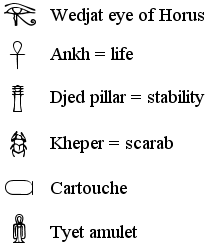Amulets and Talisman's and Gemstones
Protective devices worn around the body, or placed next to other objects, to protect them from various evils -- were common in all societies and all periods of antiquity, and their use was accepted as normal by secular, religious, and "scientific" authorities (i.e., the physicians). Almost anything could serve as an amulet -- a red string wound around the wrist, a stone carried in a small pouch around the neck, or a piece of iron tied to one's bed. Such amulets could be prepared at home, and called for no special knowledge or technical skills. Given their mundane nature, such amulets often are hard to identify -- for when we come across a decorated ring, for example, how can we tell whether it was an amulet or merely a piece of jewelry?
 Here are some amulets,
which were often used as jewelry in ancient Egypt.
Here are some amulets,
which were often used as jewelry in ancient Egypt.

The amulet in the shape of a scarab is perhaps the best known of all the amulets. It first appeared in the First Intermediate Period and was manufactured until the Graeco-Roman Period and was also made in Syria and Palestine. Every material known to the Egyptians was used to make scarabs.
ANKH ![]() A cross having a loop for its upper vertical arm (sometimes also spelled Anhk).
The Ankh, known in Latin as a crux ansata ("handle-shaped
cross"), is the Egyptian hieroglyphic symbol for "life". The
physical appearance of an Ankh suggests that perhaps it's original meaning was a
sandal strap, although it has also been seen representing a magical knot. The
Ankh has also been used in other societies and has different meaningsThe
Ankh is also one of the basis for the Christian
cross (the other of which is the swastika), although it is said that the Ankh
represents the unity of the male and the female, which is the basis for eternal
life — the upper oval represents the womb of the woman, and the lower vertical
line represents the sexual organ of the male. Symbolically, the removal of the
female womb from the Christian cross represents the removal of women from the
center of the trinity (which was the mother, father, and son, but is now the
father, son, and holy spirit). The ankh is also a sign of fertility and is now
used as an attribute or sacred emblem, symbolizing generation or enduring life.
A cross having a loop for its upper vertical arm (sometimes also spelled Anhk).
The Ankh, known in Latin as a crux ansata ("handle-shaped
cross"), is the Egyptian hieroglyphic symbol for "life". The
physical appearance of an Ankh suggests that perhaps it's original meaning was a
sandal strap, although it has also been seen representing a magical knot. The
Ankh has also been used in other societies and has different meaningsThe
Ankh is also one of the basis for the Christian
cross (the other of which is the swastika), although it is said that the Ankh
represents the unity of the male and the female, which is the basis for eternal
life — the upper oval represents the womb of the woman, and the lower vertical
line represents the sexual organ of the male. Symbolically, the removal of the
female womb from the Christian cross represents the removal of women from the
center of the trinity (which was the mother, father, and son, but is now the
father, son, and holy spirit). The ankh is also a sign of fertility and is now
used as an attribute or sacred emblem, symbolizing generation or enduring life.
|
Specially prepared objects — of stone, metal, wood, parchment and so on — inscribed with magical signs, characters or drawings. Once endowed with magical properties, the object is believed to bring the owner good luck, success, health and virility. The power of a talisman can derive from nature, directly from God, or from a magical ritual, such as those described in the grimoires, textbooks of ceremonial magic.
|